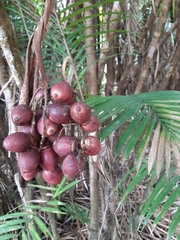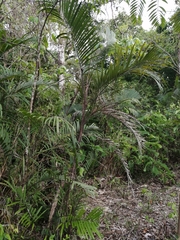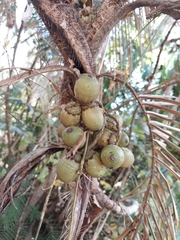

|
|
|
|
Family: Arecaceae
corozo, more...Uvito
|
Descripción: Palma que crece en colonias de 2 ó más tallos. Troncos de 1 a 10 m de alto, cubiertos de espinas negras, largas, delgadas y cilíndricas. Hojas pinnadas, con 24-48 folíolos a cada lado del raquis. Pecíolo y raquis con espinas. Inflorescencias con espatas espinosas. Flores blancas o amarillentas. Frutos globosos, de 3-4.5 cm de largo, verdes, tornándose morados o negros al madurar. Datos Ecológicos: La especie crece a bajas y medianas elevaciones, en bosques húmedos o muy húmedos. En Panamá se encuentra en las provincias de Chiriquí, Coclé, Colón, Darién, Los Santos, Panamá y Veraguas. Común en áreas pantanosas o inundables. Florece y fructifica de mayo a diciembre. Especies Parecidas: A menudo se confunde con LK bactc2 Bactris coloradonis LK2 , pero en B. coloradonis el tronco generalmente es solitario. También se puede confundir con LK bactba Bactris barronis LK2 , pero en B. barronis el raquis no presenta espinas y los folíolos tienen las nervaduras muy reticuladas. Usos: El tronco se emplea en la construcción de paredes de ranchos. Los frutos maduros son comestibles. Mongo lolo, Palma brava Small, monoecious tree, 3-10 m tall, forming small and dense to large and open thickets (usually small and dense in open areas), sometimes leaning; trunk 4-6 cm diam; leaves often persisting until plants are as much as 5 m tall; internodes 13-26 cm long, prominently spiny, the spines 1-8 cm long, with spineless leaf scars ca 5 cm long; petiole, rachis (especially lower side), and often parts of lower leaf surface +/- furfuraceous-scaly. Leaves regularly pinnate, variable, 0.7-4 m long, densely spiny on petiole and most of rachis with spines mostly 1-6.5 cm long, black or brown, the longest near base of petiole to 11 cm long; petioles 1-1.5 m long, the rachis round on lower side (drying sulcate), triangular along most of its length on upper side; pinnae on +/- same plane, 30-60 cm long, 0.8-3 cm wide, the sides +/- parallel, the lower surface sometimes with furfuraceous bands, the apex oblique, very short or to 10 cm long, the margins prominently dark-setose with small setae 1-3 mm long. Spathe 40-60 cm long, +/- woody and persisting in fruit, the broadened part 22-32 cm long, sparsely to densely black-setose with the setae 5-20 mm long, the narrow base of spathe usually lacking setae; spadix with 9-17 stout branches, the peduncle furfuraceous-scaly, the floriferous part 20-30 cm long; flowers cream-colored; staminate flowers sessile, 7-8 mm long, the petals 3, thick, ovate, acuminate, the filaments connate to about the middle; staminodial ring ca 2 mm high; pistillate flowers ca 6 cm long, their calyx accrescent, cuplike, the outer envelope ca 3 mm long at anthesis, the inner envelope ca 1 mm long, soon becoming much larger than the outer ones. Fruits held in a diffuse cluster, ellipsoid to ovoid, to 4 cm long and 3 cm broad, obtuse to rounded at apex with a small point, furfuraceous-scaly, becoming dull purple at maturity; exocarp thick; mesocarp fibrous, sweet; cupule bluntly crenate, the outer series much smaller than the inner; seed 1. Bailey 162 (type of B. superior), Croat 8567,10740. Common throughout the island; locally very abundant. Usually flowering in the dry season, with the fruits maturing in the rainy season or early dry season. A typical individual flowered in March and lost its fruits in late December. The species may also flower during the middle of the rainy season. Bactris augustinea Bailey, which represents a more depauperate form of this species, grows in more exposed places, such as along the margin of the lake and on roadsides (e.g., the type locality near Summit Garden, Canal Zone). These plants are much shorter, are colored a lighter green, and have leaves that are much smaller, with leaflets closer together and directed somewhat upward, compared to those plants occurring in the forest. No other differences have been detected between those plants inhabiting the shore and those in the forest. The specimen of B. superior described by Bailey (1933) from BCI is no doubt also B. major; it has unusually well-developed leaves and probably represents the other extreme from B. augustinea, having been collected within the forest. Otherwise the plant falls well within the limits of variability of B. major. Bailey (1933) described his collection 293 as being 15 m tall. I have seen no Bactris on BCI as tall as that, but Bailey's photographs, which accompany the type specimen, show a plant that is probably not more than 10 m tall. Abundant along coasts of Central America and northern South America; Trinidad and Tobago. In Panama, known principally from tropical moist forest on both slopes of the Canal Zone and in Panama and Darien; known also from tropical dry forest in Los Santos. |















































































